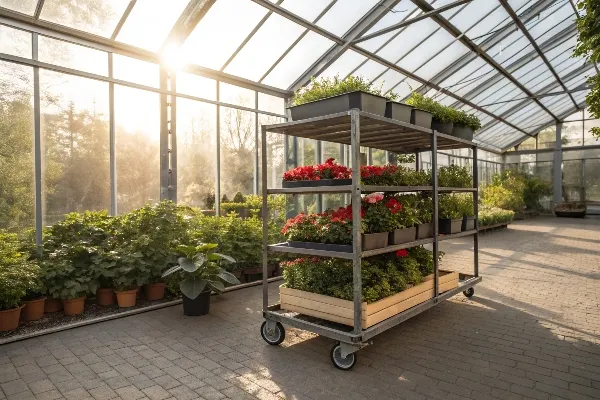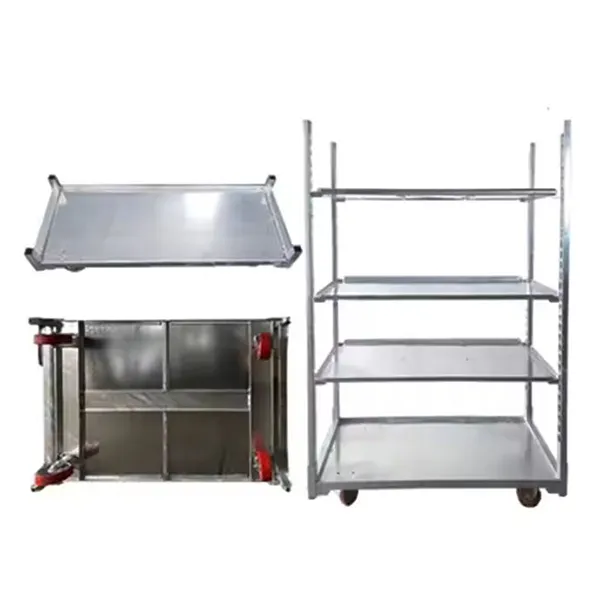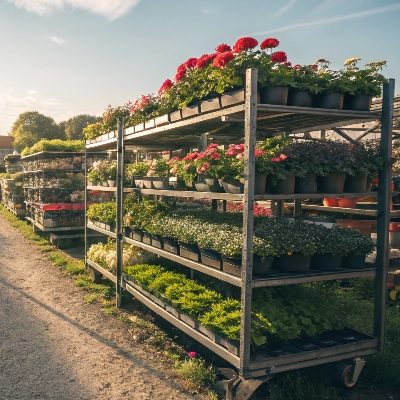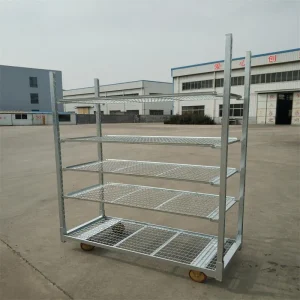Struggling with inefficient plant or goods transport leading to costly damage and wasted labor? Are storage limitations and logistical bottlenecks hindering your greenhouse, nursery, or warehouse productivity? As dedicated Danish Trolley Manufacturing plants, we see these challenges daily and offer a proven solution.
A Danish Trolley, also known as a horticulture trolley, flower trolley, or plant trolley, is a modular cart system designed for efficient material handling. It features a robust base with wheels (casters), removable upright posts, and height-adjustable shelves. Primarily used in horticulture (greenhouses, nurseries, garden centers) for transport, storage, and display, its durability and versatility make it invaluable for logistics warehouses, farms, and distribution, boosting efficiency and controlling costs.

danish-flower-trolley
What Exactly Constitutes a Danish Trolley System?
Think of the Danish trolley system as the unsung hero of efficient operations in many industries. It’s a brilliantly simple yet highly effective modular platform, originally perfected for the fast-paced Dutch flower auctions. As manufacturers, we build these systems focusing on their core, interchangeable components:
- The Base: This is the foundation, typically constructed from durable steel to handle substantial weight (load capacity). It includes secure sockets for the posts and is fitted with high-quality wheels (casters) for smooth mobility.
- The Posts: Usually four strong, upright supports made from galvanized steel. They slot firmly into the base and feature evenly spaced holes or slots along their length.
- The Shelves: These are the versatile work surfaces. Available in various materials like metal mesh shelf, treated plywood shelf, or durable plastic shelf, their defining feature is being adjustable shelves. They can be quickly repositioned at different heights along the posts to accommodate items of varying sizes.
This very modularity is the key to the Danish trolley’s success. Transporting tall flowering plants one day and short bedding packs the next? Simply change the shelf spacing. This adaptability makes the Danish trolley (often recognized by its common type, the CC Container) a vital tool for material handling across the entire horticulture supply chain and increasingly in logistics and warehouse applications. Our role as a manufacturer is to ensure these parts fit together perfectly, providing maximum reliability.
Why are Danish Trolleys Considered Indispensable for Greenhouses and Nurseries?
For Greenhouse Growers and Nursery Operators, the Danish trolley isn’t just a piece of equipment; it’s often central to the entire operational flow. Picture the journey of a plant: from propagation tray to pot, through various growing stages, internal transport across the facility, consolidation for orders, loading onto trucks, and perhaps final display in a Garden Center. Employing Danish trolleys streamlines virtually every one of these steps.
Here’s the tangible impact we, as manufacturers, see our trolleys making daily:
- Significant Reduction in Plant Damage: Less manual handling equals less risk. Plants loaded onto the stable, adjustable shelves of a plant trolley are moved smoothly, minimizing damage to delicate stems, leaves, or roots during transport within the often-congested greenhouse or nursery environment.
- Maximizing Valuable Space: In commercial growing, space is money. Horticulture trolleys allow growers to effectively utilize vertical space for growing, drying, storage, or order staging. This boosts the productive capacity of a facility. Furthermore, many trolley bases are nestable, and posts/shelves removable, for compact storage when not in use.
- Boosting Labour Efficiency and Workflow: The difference between moving plants one or two flats at a time versus rolling dozens on a single flower trolley is immense. This translates directly into substantial labor savings and faster order fulfillment – crucial factors for businesses focused on integrated cost control. The ergonomic design also helps reduce worker fatigue.
- Unmatched Operational Versatility: The same trolley can be used for propagation, internal transport, temporary storage, drying racks, order picking, and even as mobile retail display units. This multi-functionality makes it a highly cost-effective investment.
Our manufacturing process emphasizes features like high-performance, smooth-rolling casters and robust, corrosion-resistant finishes (like hot-dip galvanized steel) to guarantee our trolleys withstand the demanding, often damp, conditions of greenhouse and nursery life. Explore our purpose-built Flower Trolley range.
Beyond Horticulture: How Do Logistics Warehouses and Farms Benefit?
While the Danish trolley earned its stripes in horticulture, its fundamental advantages – modularity, mobility, strength, and space efficiency – translate powerfully to other sectors. We regularly supply these versatile carts to a wide array of businesses beyond traditional growers:
- Logistics Warehouses & Distribution Hubs: They excel at order picking tasks, moving goods between sorting and packing stations, providing flexible temporary storage, and facilitating internal transport. Their maneuverability is a significant plus in busy warehouse aisles.
- Retail Operations (especially Garden Center Chains): Streamlining the crucial flow of stock from delivery vehicles to backroom storage and then onto the sales floor. They often serve double duty as easily replenishable mobile display units, cutting down on shelf-stocking time.
- Farms & Agricultural Bases (Fruit and Vegetable): Useful for harvesting operations, transporting produce from field to packing house, moving tools and supplies, and providing temporary storage. Their durability is key in these often rugged environments.
- Municipal Greening Departments & Landscape Contractors: Efficiently moving plants, soil, mulch, tools, and equipment to various work sites.
- Manufacturing Facilities: Kitting parts for assembly lines, transporting components, organizing materials within the production area.
In all these applications, the core benefits remain consistent: improved operational efficiency, better space utilization, reduced manual material handling (leading to improved safety and less product damage), and enhanced organization. The inherent durability we build into each trolley, particularly those using hot-dip galvanized steel, ensures a long service life even in tough warehouse conditions, contributing significantly to effective cost control.
Anatomy of Excellence: What are the Key Components of a High-Quality Danish Trolley?
Investing in Danish trolleys means investing in equipment critical to your daily operations. As manufacturers dedicated to reliability and service life, we know that cutting corners on components leads to frustration and added costs down the line. Understanding the anatomy of a quality trolley helps you appreciate the difference:
- The Base: This is the trolley’s foundation. We utilize high-grade steel, ensuring structural strength and optimal load capacity. Key quality indicators include reinforced corners, robust welding, and precisely formed sockets for the posts. Nestable bases offer valuable space savings for storage.
- The Posts: These uprights must be strong, perfectly straight, and manufactured with accurate, consistent spacing for the adjustable shelves. Hot-dip galvanized steel provides the best long-term protection against corrosion, essential in humid greenhouse conditions or outdoor use.
- The Shelves: Shelf selection impacts both functionality and durability. Common high-quality options we provide include:
- Metal Mesh Shelf: Offers excellent drainage and airflow (vital for horticulture), is extremely durable, and easy to clean. Often the top choice for wet environments.
- Plywood Shelf: A solid, cost-effective choice, typically using marine-grade or specially treated plywood for water resistance. Ideal for drier goods or when a flat, continuous surface is preferred. Metal edging can enhance longevity.
- Plastic Shelf: Lightweight, completely waterproof, and very easy to sanitize. Often used in food-related applications or where hygiene is paramount.
The ease and security of shelf adjustment are critical to the trolley’s overall versatility.
- The Wheels (Casters): These are crucial for maneuverability, durability, and safety. Important factors include:
- Material: High-quality Nylon (for strength and load capacity), Rubber (for quieter operation and grip), or Polyurethane (non-marking, durable).

Our focus on manufacturing these components to exacting standards is how we guarantee our Danish trolleys deliver the reliability and longevity our customers depend on. Quality construction translates to dependable performance.
Hot-Dip Galvanized vs. Electro-Galvanized: Why Does it Matter for Durability?
A frequent question we receive as manufacturers concerns the type of galvanization used on steel components like the base and posts. For maximum durability, corrosion resistance, and long-term value – especially in environments like greenhouses, nurseries, outdoor storage areas, or facilities with regular wash-downs – hot-dip galvanized steel is significantly superior to electro-galvanized (also known as zinc plating).
Here’s the crucial difference:
- Process & Bond: Hot-dip galvanizing involves immersing the fully fabricated steel part (e.g., a trolley base) into a bath of molten zinc (~450°C). This creates a thick, tough series of zinc-iron alloy layers that are metallurgically bonded to the steel, covered by a layer of pure zinc. It becomes part of the steel. Electro-galvanizing uses an electrical current to deposit a much thinner, purely mechanical layer of zinc onto the surface.
- Corrosion Protection: The thick, bonded coating of hot-dip galvanizing provides substantially longer protection against rust. Even if the surface is scratched down to the steel, the surrounding zinc acts sacrificially to protect the exposed area. The thin coating of electro-galvanizing offers much less protection and can be easily compromised by scratches.
- Complete Coverage: The dipping process ensures that all surfaces – including edges, corners, inside tubes, and weld points – are fully coated and protected. Electro-galvanizing can struggle to provide consistent coverage in recessed areas or sharp corners.
- Abrasion Resistance: The tough alloy layers formed during hot-dipping are actually harder than the base steel itself, providing excellent resistance to the bumps and scrapes inherent in daily material handling.
While hot-dip galvanized Danish trolleys may have a moderately higher initial investment cost, the dramatically increased service life (often lasting decades even in harsh conditions) and reduced maintenance make them the far more economical choice in the long run. This directly supports effective cost control. As a quality-focused manufacturer, it’s the finish we strongly recommend for ensuring maximum durability. You can see this robust finish on our standard Danish Flower Trolley CC Containers.
Measuring the Gains: How Danish Trolleys Quantifiably Improve Workflow Efficiency?
The adoption or upgrade of a Danish trolley system isn’t just about convenience; it’s about achieving measurable improvements in operational efficiency. These gains directly impact your bottom line by saving time, reducing waste, and optimizing labor in your greenhouse, nursery, warehouse, or retail setting.

danish-flower-trolley
Let’s look at the key areas where efficiency is boosted:
- Reduced Material Handling Steps: This is often the most significant impact. Instead of staff repeatedly picking up and putting down individual pots, flats, or boxes, entire batches are loaded onto a trolley once and moved as a single unit through multiple process steps (transport, storage, staging). Fewer touches mean less wasted motion and reduced risk of damage.
- Faster Loading & Unloading: Standardized trolleys dramatically speed up the loading and unloading of trucks, especially if vehicles are equipped with compatible ramps or tail lifts. This reduces vehicle waiting times and gets products moving faster along the supply chain.
- Optimized Space Utilization: Efficient vertical storage on adjustable shelves maximizes the use of cubic space, potentially delaying or eliminating the need for costly facility expansions. Nestable bases further reduce the storage footprint of empty trolleys.
- Streamlined Order Picking & Fulfillment: Using trolleys for order picking in warehouses or nurseries allows staff to collect multiple items or orders simultaneously, reducing travel time and increasing picking rates.
- Improved Ergonomics: Well-maintained trolleys with quality casters are easier and safer for employees to maneuver than carrying heavy loads manually, contributing to a healthier and potentially more productive workforce.
As manufacturers, we take pride in engineering Danish trolleys that facilitate these tangible efficiency improvements, helping our clients optimize their workflows and reduce operational friction.
Danish Trolleys and Integrated Cost Control: Analyzing the Long-Term Value (ROI)?
In today’s competitive business environment, high sensitivity to integrated cost control is essential for survival and growth across all sectors we serve – from Fruit and vegetable planting bases to sophisticated logistics warehouses. Viewing Danish Flower Cart solely through the lens of their initial purchase price is short-sighted. They represent a powerful investment in long-term operational savings and efficiency, delivering a strong Return on Investment (ROI).
Let’s break down how high-quality trolleys contribute to cost control:
- Significant Labour Cost Reduction: As discussed, minimizing handling time and streamlining transport translates directly into fewer labor hours required per unit handled or order fulfilled. This is often the largest and most immediate cost saving.
- Lower Product Damage Costs: Reducing losses from dropped pots, broken stems, or damaged goods during internal transport and storage directly protects your revenue and reduces waste disposal costs.
- Extended Equipment Lifespan: Investing in durable, hot-dip galvanized trolleys from a reputable manufacturer means significantly longer service life compared to cheaper, less robust alternatives. This dramatically lowers the annualized cost of ownership and reduces capital expenditure on replacements.
- Reduced Facility Costs: Optimizing space utilization through vertical storage and nestable designs can potentially reduce the need for expensive expansions or reliance on off-site storage.
- Increased Throughput & Revenue Potential: Faster processing times and more efficient workflows can enable businesses to handle greater volumes, potentially increasing revenue without a proportional rise in fixed costs.
We understand that cost control is paramount. That’s why our manufacturing philosophy prioritizes durability and reliability. Our Danish trolleys are designed not just to function, but to provide sustained economic value throughout their long service life.
upply Stability and Compliance?
For businesses whose operations hinge on the smooth flow of goods facilitated by Danish trolleys – think large Nursery Operators during spring rush, Garden Center Chains managing seasonal inventory, or time-critical Logistics providers – assurance of delivery and supply stability is absolutely critical. Furthermore, depending on the application or region, adherence to specific regulatory and certification compliance standards might be necessary.
As your chosen Danish Trolley Manufacturing plant, we prioritize these aspects to build lasting partnerships:
- Collaborative Demand Planning: We actively encourage clients to share their forecasts and anticipated needs. This allows us to align our production planning and raw material procurement proactively, minimizing the risk of delays.
- Scalable Production Capacity: Our manufacturing facilities are designed to handle fluctuations in demand, ensuring we can scale production effectively to meet both standard and large-volume orders.
- Strategic Component Inventory: We typically maintain a healthy stock of standard, high-turnover components like bases, posts, common adjustable shelves (metal mesh shelf, plywood shelf), and popular caster types. This allows for faster assembly and dispatch of frequently ordered configurations.
- Commitment to Quality Standards: Our Danish Flower Cart are manufactured to meet or exceed generally accepted industry standards for load capacity, structural integrity, safety, and durability. We stay informed about evolving compliance requirements and can discuss specific needs related to your operation.
- Transparent Communication: We believe in maintaining open and honest communication regarding order progress, production status, and estimated delivery timelines.


Our commitment extends beyond simply fabricating metal. We aim to be a reliable, dependable partner in your supply chain, consistently delivering high-quality, compliant Danish trolleys when you need them. If you have specific requirements or need to discuss large orders, please get in touch with us.
Frequently Asked Questions (FAQs)
What are the main advantages of using Danish trolleys over other types of carts?
The key advantages are their modularity (adjustable shelves), industry standardization (especially CC Container types facilitating exchange), high load capacity combined with maneuverability, excellent durability (especially when hot-dip galvanized), and versatility for transport, storage, and display across horticulture and logistics.
How easy is it to assemble a Danish trolley upon delivery?
Assembly is typically very straightforward. Danish trolleys usually ship disassembled to save space and cost. The posts simply slot into the sockets on the base, and the adjustable shelves are placed onto the posts at the desired height. No special tools are usually required.
Can you use Danish trolleys outdoors?
Yes, especially if they are hot-dip galvanized. This finish provides excellent protection against rust and weather. However, prolonged exposure to harsh elements will still affect components like wheels over time. Regular checks and maintenance are recommended for outdoor use.
What is the difference between a Danish trolley and a CC Container?
“CC Container” often refers specifically to trolleys that are part of the Container Centralen pooling system, built to their precise standards for interchangeability within that pool. “Danish trolley” is a broader term for this style of horticulture trolley / plant trolley, which may or may not meet the exact CC specifications but shares the same basic design principles (base, posts, adjustable shelves).
How do I determine the right type of shelf (metal mesh, plywood, plastic) for my needs?
Metal mesh shelves are best for horticulture due to drainage and airflow. Plywood shelves offer a solid, cost-effective surface for general goods. Plastic shelves are ideal for hygiene-sensitive areas or very wet environments. Consider the items you’ll be handling, the environment, and your budget. As manufacturers, we can help advise.
Is financing available for purchasing Danish trolleys?
Financing options may be available depending on the manufacturer or through third-party equipment financing companies. It’s worth inquiring about possibilities, especially for larger quantity orders, as it can help manage the initial investment.
Key Takeaways:
- Danish Trolleys (Horticulture Trolleys, Flower Trolleys) are modular, wheeled carts vital for efficiency in horticulture, logistics, retail, and agriculture.
- Core components include a base, posts, adjustable shelves (e.g., metal mesh shelf, plywood shelf), and wheels/casters.
- They deliver significant benefits: reduced product damage, optimized space, lower labor costs (cost control), improved workflow, and versatile transport, storage, and display capabilities.
- Prioritize high-quality construction, especially hot-dip galvanized steel, for maximum durability and long service life.
- Choose a manufacturer known for reliability, custom compatibility, delivery stability, quality materials, and excellent support.
- Danish trolleys represent a strategic investment that enhances operational efficiency and provides substantial long-term value.
Ready to revolutionize your material handling processes with the industry’s most trusted and versatile solution? Contact us, your expert Danish Trolley Manufacturing plant, today. We are eager to understand your specific needs and help you configure the perfect trolley system to drive efficiency, reliability, and growth for your business. Let’s build a more efficient future together!




